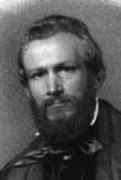Person: Du Bois-Reymond, Paul

Paul du Bois-Reymond gave a continuous function whose Fourier series diverges at a point (and in fact at a dense set of points).
Mathematical Profile (Excerpt):
- Felix du Bois-Reymond was from Neuchâtel but moved to Berlin in 1804 where he was a teacher at the Kadettenhaus.
- Napoleon intervened in 1803 with the Act of Mediation which substituted a new Swiss Confederation for the Helvetic Republic, producing even closer ties with France.
- It was an upbringing which saw Paul totally fluent in both French and German.
- From Neuchâtel, Paul went to the Gymnasium in Naumburg and then entered the University of Zürich in 1853.
- Émile had been elected to the Prussian Academy of Sciences two years earlier and Paul, striving to follow, began to study medicine.
- In 1854, Paul du Bois-Reymond published four papers which studied physiological problems.
- His doctoral studies were supervised by Kummer and du Bois-Reymond was awarded his doctorate by the University of Berlin in 1853 for his thesis De aequilibrio fluidorum Ⓣ(On the equilibrium of fluids).
- After his doctorate du Bois-Reymond was appointed to teach mathematics and physics at a secondary school in Berlin.
- In 1864, while still teaching at the secondary school, du Bois-Reymond published Beiträge zur Interpretation der partiellen Differentialgleichungen mit drei Variabeln Ⓣ(Contributions to the interpretation of partial differential equations with three variables).
- Following the publication of this important work, du Bois-Reymond was appointed to a chair at the University of Heidelberg in 1865.
- Finally, after ten years at Tübingen, where he supervised the doctorates of a number of students the most famous of whom was Otto Hölder, du Bois-Reymond was appointed to a chair at the Technische Hochschule Charlottenberg in Berlin.
- Although du Bois-Reymond got on well with Weierstrass and the two shared many similar mathematical interests and concerns for rigour, the same could not be said for members of Weierstrass's school with whom relations were strained.
- In particular du Bois-Reymond and Schwarz were not on good terms.
- Du Bois-Reymond's work is almost exclusively on calculus, in particular partial differential equations and functions of a real variable.
- In 1873 du Bois-Reymond was the first person to give an example of a continuous function whose Fourier series diverges at a point.
- Perhaps what was even more surprising, the Fourier series of du Bois-Reymond function diverged at a dense set of points.
- Du Bois-Reymond published an example of a continuous function which is nowhere differentiable in 1875.
- Although there is no clear evidence that Cantor was guided to his "diagonal argument" from du Bois-Reymond's work, there is clear evidence that du Bois-Reymond had essentially found the diagonal argument in 1875.
- In 1880 du Bois-Reymond pointed out the importance of nowhere dense sets which cannot be appropriately covered.
- Du Bois-Reymond published Die allgemeine Functionentheorie Ⓣ(General complex analysis) in 1882.
- A majority of educated people will admit an infinite in space and time, and not just an "unboundedly large".
- Moreover, hasn't the attempt in mechanics to go back down to the smallest active elements long ago introduced into science the atom, the embodiment of the infinitely small?
- Although never a mathematician of the first rank, nevertheless the contributions by du Bois-Reymond during the 1870s and early 1880s were highly significant.
Born 2 December 1831, Berlin, Germany. Died 7 April 1889, Freiburg, Germany.
View full biography at MacTutor
Tags relevant for this person:
Analysis, Origin Germany
Thank you to the contributors under CC BY-SA 4.0! 

- Github:
-

- non-Github:
- @J-J-O'Connor
- @E-F-Robertson
References
Adapted from other CC BY-SA 4.0 Sources:
- O’Connor, John J; Robertson, Edmund F: MacTutor History of Mathematics Archive
